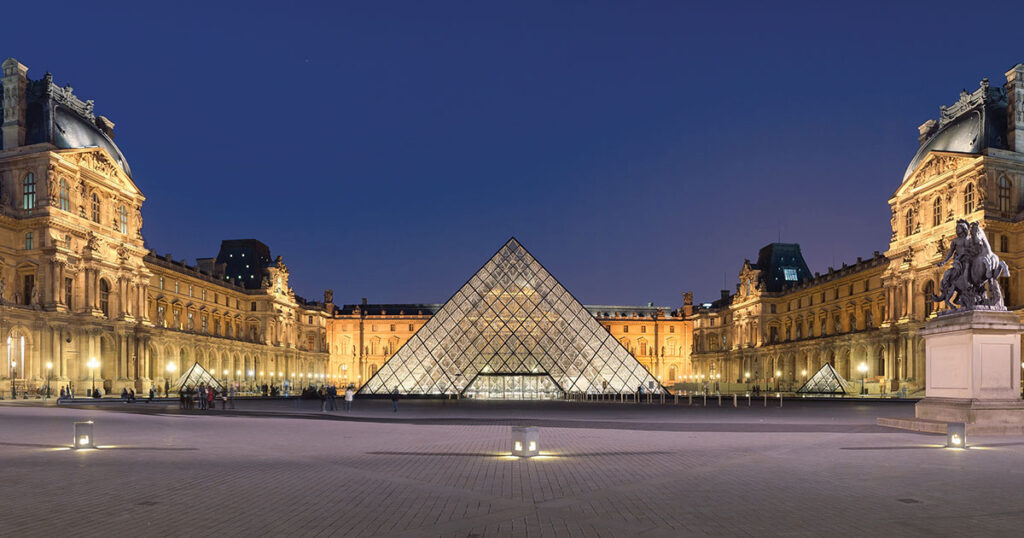
The Louvre: The Many Lives of the World’s Most Famous Museum by James Gardner; Atlantic Monthly Press, 416 pp., $30
In The Louvre, American architecture critic James Gardner aims to tell the story of this complex Paris building by proceeding along three fronts: architectural, institutional, and historical. Immense culture, a tight grasp of chronology, and a steady hand would have been imperative for success in such a vast project.
Gardner is most at ease when he deals with architecture. He guides the reader through the innumerable additions and alterations that transformed a primitive 13th-century fortress—it could have easily fit into one of the main courtyards of the present palace—into the huge structure that is today’s Louvre museum. It would, however, have been helpful if he had decided who his intended reader was. Is he writing for experts, a more general public, or both? For instance, to give an idea of the breadth of the Grande Galerie—the Louvre’s most popular painting gallery, a narrow space that runs along the whole building—he makes two comparisons. The first is the arcaded perimeter of the Piazza San Marco in Venice, an urban setting well known and easy to visualize. But the second example—the curtain wall built by Charles V along the Seine from the Louvre to the western point of the wall of Paris, the Tour du Bois—is so arcane that it would require additional illustration and commentary to make it comprehensible. Such a reference adds nothing to his explanation but an extra layer of confusion.
True, describing the evolution of medieval palaces can be arduous. Presumably to make the detailed technical descriptions more palatable, Gardner frequently veers into anecdotes only tenuously related to his subject. The reader may be puzzled, for example, by being treated to the details of the life of Italian nobleman Concino Concini, the disreputable favorite of Marie de Médicis, or of the goings-on in the renowned literary salon of Mme de Rambouillet, who received many of the eminent writers of the first half of the 17th century. The fanciful story Gardner tells of Louis XVI’s flight to Varennes similarly serves no purpose. When he writes that Marie-Antoinette lost her way in the labyrinth of medieval streets adjacent to the Louvre, as she tried to join the king and their children about to flee Paris, he implies that she was alone, which was most improbable.
Over time, the Louvre has served three distinct purposes. Up to 1682, it was a functioning royal palace in which the king and his family lived, and where the work of the government took place. This period ended with Louis XIV’s decision to move the court to Versailles. The Louvre, however, did not remain empty. Five royal academies moved into the palace, where they remained until the 1789 revolution; alongside these respectable learned academicians, painters and sculptors were settled in various studios and dwellings. Gardner gives a lively description of the tumultuous atmosphere in the palace. Fights erupted. Caretakers complained about the incredibly dirty state of the corridors and the erratic behavior of some artists. At one point, Chardin and Quentin de la Tour had one of their neighbors committed to an insane asylum. But the annual exhibition of paintings, known as the Salon because it took place in the space called le Salon Carré, attracted many viewers. It likewise paved the way for the last transformation of the Louvre. In 1793, at the height of the Terror, the revolutionary government established the
Louvre as a public museum where royal collections, as well as works confiscated from émigrés, monasteries, and churches, were displayed in a way intended to be instructive to viewers. The number of masterpieces on show increased spectacularly as Napoleon’s victorious armies pillaged paintings and sculptures throughout Europe.
Gardner fails to convey the enthusiasm this new educational function generated. At the time, public access to works of art was unprecedented. Everyone visited the Louvre: artists, masters and pupils, the inquisitive, the idle. Again Gardner digresses, devoting many pages to the “kidnapping” of the Mona Lisa in 1911 and the painting’s subsequent trips to the United States, before circling back to Queen Elizabeth’s Paris visit in 1957 and, for good measure, a few details on Queen Victoria’s tour of the Louvre in 1855. Because he is mainly interested in architecture, Gardner concludes by discussing at length the creation of the Grand Louvre in the 1980s and the particulars of the Pyramid.
The project consisted of three parts. The first, completed in 1989, entailed the creation of a great central reception area crowned with I. M. Pei’s Pyramid, which allowed access to the museum’s three main wings; the second, an overhaul of the Louvre’s façades; and the third, extensive archaeological work on the medieval Louvre. But perhaps one of the most significant changes occurred in 1993, when a vast underground shopping center, accessible to ticket-holding museum visitors, was opened.
I have to admit that my annoyance with the book crested when the author declared that “visitors who know the Louvre only as it has been since 1993 cannot imagine how much it has changed for the better. Before that time it was surely a great and noble museum, but hardly a pleasure to inhabit and certainly not a source of fun.” I can assure James Gardner that in those prehistoric times, when one could enter the Louvre without standing in line, when one could wander in the Grande Galerie without jostling the crowds, when one could watch artists copy great paintings, the museum was a source of unending pleasure.

